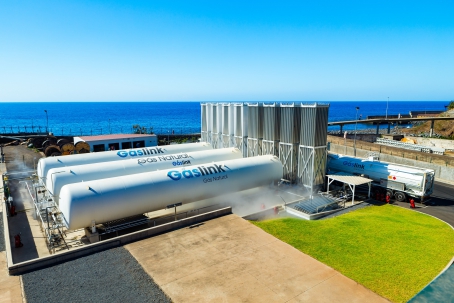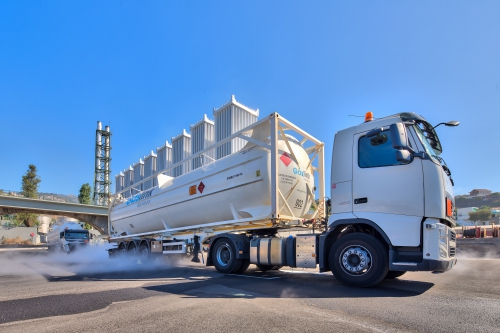[NGW Magazine] Madeira Sets Benchmark for Island LNG Schemes
Tiny Madeira’s LNG use has grown from zero to 0.55% of Portugal’s gas consumption in three years, built up by locally-based Grupo Sousa’s ‘Gaslink’ subsidiary, and it’s now set to grow further as the tourist industry develops.
Portugal’s gas demand last year reached a record 6.5bn m³, itself nearly 25% higher than in 2016, according to gas and power grid operator REN. But even so, the 26,000 tons of LNG (or 36 million m3 natural gas) shipped to Madeira by Grupo Sousa and distributed around the island still managed to account for 0.55% of the nation’s gas consumption. That’s not bad for a market of around 250,000 people that had no gas prior to 2014, and GS director Pedro Frazao is pleased to take some of the credit.
“This is the biggest operation of its kind in the Atlantic,” he told a December 2017 LNG conference in Lisbon.
The Gaslink virtual ‘pipeline’ is actually a trading route between Portugal’s LNG terminal at Sines (run by REN), through Sousa’s shipping terminals in Lisbon and the Madeiran port of Caniçal and nearby LNG depot (also Sousa-run), using road trucks at either end, plus two containerships each week.
LNG is transported in standardised ISO tanks, also widely used by other operators on the western side of the Atlantic to deliver LNG to small-scale customers in the US Gulf and Caribbean. Gaslink’s ISO containers were supplied by US-based LNG equipment provider Chart Industries.
“During 2017, Grupo Sousa/Gaslink transferred circa 26,000 tons of LNG from Sines Terminal to our Madeira LNG satellite plant for electricity production. That’s equivalent to nearly 1,500 LNG ISO containers in this period,” Frazao told NGW earlier this month. Additionally, it delivered one full ISO container last year (in December) for the first LNG-fuelled cruiseship ever to refuel in Madeira.
How did this trade develop?
A consortium of Gaslink and Galp won an international tender run by the island’s public electricity company, Electricidade da Madeira, to supply the latter with LNG – an attempt by the island to improve air quality. Until two months ago, the power plant that GS supplied – unit three at the Vitoria thermal power station – was Gaslink’s sole client for LNG.

The satellite plant at the Madeiran port of Caniçal can store 600 m3 of LNG (Photo credit: Grupo Sousa/Gaslink)
As part of this investment, Portugal’s gas and power grid operator REN introduced flexible hoses at its large LNG terminal at Sines – effectively creating a small-scale facility there – and enabling the ISO containers to be filled, then loaded onto road trucks. The ISO tanks – there are now 55 in use, each 40 feet long – are then trucked from Sines to the port facility at Lisbon, where they are loaded on to the containerships and ferried to Madeira.
Gaslink built an LNG satellite plant on the island at Caniçal, with three cryogenic tanks each of 200 m3 (for a total capacity of 600 m3 LNG), and with a gas sendout flow capacity of up to 12,000 m3/hr.
LNG may account up to nearly a quarter of Madeira’s overall energy supply mix, Frazao told the conference. The power plant has been fuelled with regasified LNG now for around four years. Gaslink though has ambitions to extend its Madeiran market, by signing up other clients for LNG, and developing another LNG satellite plant.
Tourism, in the form of hotel stays and cruiseship visits, is a mainstay of the Madeiran economy. The Savoy Palace Hotel is being redeveloped in the capital Funchal, with plans agreed to expand its number of rooms from 828 to 1,128. Plans call for new LNG satellite units to be built in the city able to supply the hotel and a new hospital to be built in the future there which is also being prepared to run on regasified LNG, Frazao told delegates.
LNG bunkering in Madeira
Portugal’s main gas supplier Galp made headlines December 21 when it said it had conducted not just the first LNG refuelling carried out at a Portuguese port but also the first on any Atlantic island. The LNG supplied by Galp did indeed refuel the cruiseship AidaPrima while berthed in Funchal, December 18. But it was Grupo Sousa/Gaslink that conducted the operation, and created the supply chain that enabled this to happen.
Frazao indeed told the CWC Lisbon conference that his firm transferred the first LNG to the cruiseship a month earlier, on November 20. The first LNG streams were transferred to AidaPrima on November 20 “for systems and safety procedures overall testing,” he re-confirmed to NGW this month, noting also that Galp is correct in saying the first full LNG fuelling took place December 18.
Cruiseships are now expected to be fuelled with LNG on a weekly basis, added Frazao, starting on January 8 and running until mid-April – the peak season for winter sun holidaymakers. Indeed, he confirmed that refuellings have already occurred on both January 8 and 15. Refuelling cruiseships with LNG has been possible only thanks to the logistical backbone developed by Sousa, he added, and now this could significantly scale Gaslink’s operations.
“We believe such LNG virtual pipelines can be replicated in other parts of the world such as Indonesia, the Caribbean and Japan, besides of course Azores, the Canary Islands and Cape Verde,” Frazao added: “In this case, Sousa has a competitive advantage.”
AidaPrima is one of two Aida Cruises vessels using a port generator powered by natural gas. In 2016 it became the first cruiseship routinely to use LNG whilst in port. Since 2000 Aida Cruises belongs to cruise giant Carnival Group, which has seven large oceangoing cruiseships on order for delivery in 2019-22 that are expected to use LNG propulsion on all their journeys.
This is likely to lead to a scaling up of LNG bunker demand from the cruising industry, as larger ships travel further solely on LNG – as the IMO 0.5% cap on sulphur in bunker fuels is implemented worldwide from January 2020.
Small-scale takes off in Portugal
Small-scale LNG has been growing for some time out of mainland Portugal’s large LNG import terminal at Sines, operated by REN and mainly used by Galp to import Nigerian and Algerian LNG.
Sines opened in 2004, primarily to handle LNG imports for regasification into the national grid and for use in power generation. But interest grew within Portugal from customers not connected to REN’s national gas network. Sines therefore opened three LNG filling stations for trucks, equipped with loading arms, so that these off-network customers could source natural gas. In 2013 REN thus loaded 3,138 road trucks with LNG.

A road truck transporting LNG inside one ISO container (Photo credit: Grupo Sousa/Gaslink)
However, the loading arms could not lift ISO containers, prompting operator REN to replace them with flexible hoses and thus enable Gaslink to develop the supply chain to Madeira. REN said it loaded 4,629 trucks at Sines with LNG, accounting for 125 mn m3 of natural gas, in 2016 – of which almost a fifth (27mn m3) was destined for Madeira.
Interest from abroad
Now there are signs that the international community is keen to learn from Madeira’s LNG experience and location. And in this context, it is worth recalling that the first US LNG cargo into Europe in mid-2016 landed at Sines, with Portugal – like Spain, effectively cut off from the competitive gas markets north of the Pyrenees – a leading market in Europe for US cargoes ever since.
Prior to the CWC conference in Lisbon, Portugal’s minister of the sea Ana Paula Vitorino met with John McCarrick, deputy assistance secretary of the US State Department’s Bureau of Energy Resources (ENR) and local US ambassador George Glass in late November.

Loading of ISO containers onto regular shipments from Lisbon to Madeira (Photo credit: Grupo Sousa/Gaslink)
"The US Department of State and the Portuguese ministry of the sea will continue to work together to help Europe diversify its energy supplies through new sources of natural gas, new vital interconnections, new maritime LNG infrastructures and LNG," the two sides agreed in a joint declaration.
US firms, such as Southern Company Gas-owned Pivotal LNG, Crowley Maritime, Jacksonville-based JaxLNG, and Eagle LNG have been instrumental in developing the use of ISO tanks to transport small LNG volumes to small-scale customers in the US Gulf, Puerto Rico and the rest of the Caribbean.
‘LNG pipeline’ to LNG matrix?
A dozen co-operation agreements were signed a few days later, December 5, between Portugal and Morocco, a few of which touched on energy with the Lisbon government alluding to electricity interconnectors between Iberia and north Africa.
Portugal’s prime minister Antonio Costa in a statement said the construction of a power interconnection could be complemented by sending natural gas from the US by sea to Portugal “that we can also distribute to Morocco" – a hint perhaps of the options of expanding a ‘LNG pipeline’ into something more like a matrix.
The Moroccan government back in mid-2016 was talking of awarding a major contract to develop a large LNG import terminal, plus two large power plants, to an international consortium.
In May 2016 the ministry said 93 companies had responded to a call for expressions of interest issued December 2015. But tendering was deferred and Rabat seems to be getting cold feet over this kind of major investment, despite Moroccan energy minister Aziz Rabbah telling Bloomberg January 14 it will "soon" tender for companies to develop the integrated project.
Portugal and the US then December 14 held their 38th Standing Bilateral Commission. It stressed their “shared interest to continue making headway in the field of LNG,” discussed strategies to “further grow the Azorean economy in partnership with US companies” citing the main Sao Miguel and Terceira islands in that context, and in particular reflected on “opportunities for a significant role of the Azores in the development of the LNG market.”
Asked by NGW if Sousa/Gaslink planned to expand its ‘LNG pipeline’ to other Atlantic islands, either inside Portugal such as the Azores, or independent neighbouring countries such as, for example, the Cape Verde islands, Frazao’s replied: “The LNG virtual pipeline concept is proven. Grupo Sousa holds the necessary logistics skills to prepare and conduct such operations. We are ready if so required.”
The Azores regional government though responded warmly September 2016 to a suggestion in a European Parliament report that some form of ‘virtual pipeline’ delivering LNG to the port of Praia Vitoria on Terceira island using ISO containers delivered by sea, could also help establish a LNG bunkering facility. However, LNG on the Azores seems still to remain a concept, if an enticing one.
Scope for LNG bunkering in mainland Portugal
If LNG-fuelled cruiseships and containerships also create demand for alternative bunkering in Portugal, an option for growing the LNG market could be to start at home.
There are as yet no facilities available for LNG bunkering/fuelling at Lisbon Cruise Terminals (LCT), renamed Lisbon Cruise Port, a private operator – owned 30% by Sousa, 40% by Global Ports, 20% by cruise operator Royal Caribbean and 10% by Creuers Del Port Barcelona – which operates Lisbon’s cruise terminals and receives half a million passengers yearly. Only marine diesel and fuel oil are available there for bunkering.
Mark Smedley



